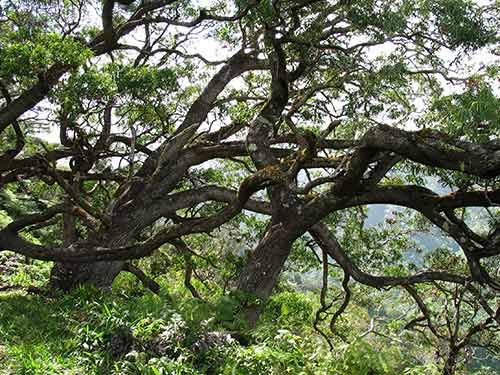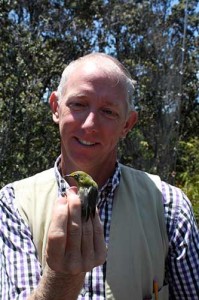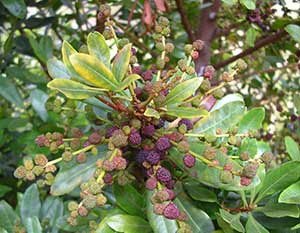Can the native species of Hawai’i hold out against invasives? Their recovery will rely on science, technology and the work of many hands.
By Sophia V. Schweitzer

For the past four years, during misty morning hours, Dr. David Flaspohler has been tramping around remote, lava-ringed forest pockets on the slopes of still-active Mauna Loa, Earth’s largest volcano, on the island of Hawai‘i. Far removed from human noise, the ocean shimmering 4,500 feet below, the conservation biologist and avian ecologist from Michigan Technological University stops frequently to listen and look for birds, among them the crimson ‘i‘iwi, elusive ‘ōma‘o and little Hawai‘i ‘elepaio, all species found nowhere else in the world.

In these forests, damp logs populated with lichen and ferns sidle up to native ‘ōlapa trees. Tree ferns with giant fronds reaching 40 feet tall grow alongside gnarly ‘ōhi‘a lehua trees. You may see tall, sturdy koa, a uniquely Hawai’ian rainforest tree, sheltering a universe of epiphytes — plants that grow on other plants — in the crannies of its trunk, while giving plentiful habitat to native species of birds, spiders and insects. The air is heavy with the scent of decaying leaves, the pulse of new and dying life.

Hawai‘i’s rainforests generally include three “structural” species. Koa, ‘ōhi‘a and tree ferns provide the conditions for balanced ecosystems. Under this triad of canopy trees and ferns, a biodiverse understory can exist. Yet, where the forests have vanished, rainforest recovery and restoration aren’t nearly as simple as ensuring the presence of these three species. The reason? Wherever a native species was cleared in the past, a problematic non-native has taken hold.
INVASION
The forest patches of Mauna Loa are known in the Hawai’ian language as kipuka, isolated land areas of varying size surrounded by lava flows dating back to the mid-1800s. They host some of the nation’s most fragile native ecosystems that contain an imperiled biodiversity without equal in the country. “Here’s an evolutionary legacy that’s unique in this world,” Dr. Flaspohler says. “In the history of life on Earth, evolution happened just one time in this way, and it will never happen again.”

Millions of years ago, far removed from any continental landmass, barren volcanic mountains surfaced from the Pacific Ocean. By wind, wings and waves, spores and seeds dropped in, as well as insects, tiny snails and a bat. A pair of finches landed. Few of these accidental arrivals survived, but over time, some species established themselves, adapting to the conditions of their habitat and co-evolving with other species in the neighborhood. The descendants of the finches, for example, evolved into a diverse family of honeycreepers. Variations in bill size and shape gave some individuals an advantage in feeding on new abundant food items like flower nectar, insects and fruits. Such changes became more exaggerated over time as groups of birds moved around and responded to new conditions. In this specialization process called adaptive radiation, single colonizing species formed dozens of new species. The rainforest became one of many unique Hawai’ian ecosystems.
But ever since the arrival of human beings, beginning around 1,700 years ago, Hawai‘i’s ecosystems have been disturbed. Deterioration accelerated dramatically after 1778, when settlers from Europe and the continental mainland began to colonize the islands. Hawai‘i’s self-contained ecosystems held no defense against the thousands of new plants and animals that they brought with them. Native species readily succumbed to introduced weeds, disease and feral livestock. Of Hawai‘i’s 1,000 native plant species growing wild, more than 90 percent are endemic, meaning that they are found nowhere else in the world. But they struggle to maintain themselves amid the 3,000 species of non-native plants.

Some of the non-natives have become problem invaders with the forests being especially hard-hit. Banana poka, a vine introduced to Hawai‘i in the 1920s as an ornamental plant, has spread throughout forests and fields to infest tens of thousands of acres. Brought in from the Azores islands, firetree, often called simply faya, a take on its Latin name, Morella faya, has spread equally beyond control. Hawai‘i has lost 50 percent of its native forests, leading the nation in extinctions and federally listed endangered species. “There’s almost no other place anywhere else in the country with such severe forest loss,” says Dr. James Boyd Friday, a forester with the College of Tropical Agriculture and Human Resources at the University of Hawai‘i.
KNOWLEDGE IS POWER
Dr. Friday studies restored koa forests on mauka lands — lands toward the mountains, or inland — across the state. “We aren’t clear yet how to restore rainforests on a larger scale,” he says. “Native forests need so much more than koa, but there is no telling, once you plant a koa tree, if the other species will fall in place.”
Dr. Flaspohler echoes a similar sentiment. “We know so little about these forest patches,” he says. “Our goal, originally, was to help with forest restoration in Hawai‘i because so much of the native forest has been converted to agriculture and pasture over the last centuries. We quickly realized, however, that we need to know much more to be efficient.”

This seems to be a theme in Hawai‘i’s conservation efforts these days: The forests need help, yes, but we can only provide that help with greater understanding of how they work. Scientists are learning surprising new things about the ways in which native and non-native species interact, which may lead to outside-the-box recovery plans over time. Take the kalij pheasant, introduced as a game bird in 1962, and the Japanese white-eye, a songbird intentionally introduced to the islands in 1929 for purposes of bug control. They are intruders, yes, especially the white-eye, which almost certainly competes with honeycreepers for food and habitat. But these birds possibly also fill a niche in the dispersal of native seeds, a task formerly done by native species now extinct. “We have to look much more at the roles of non-native species,” Dr. Friday says. “Can some of them help recovery? Or are the disadvantages greater? It’s a tricky proposition at each turn, but, for example, it may well be that a non-native forest canopy could provide the right conditions for native understory growth recovery. It’s all worth considering right now.”

This is where a new and powerful technology comes in — one that could replace hundreds of hours of hoofing it and prove invaluable for future strategies. For the last decade, Dr. Gregory Asner of the Carnegie Institution’s Department of Global Ecology at Stanford University has been leading efforts to create remote sensing imagery of the forests by way of high-altitude aircraft. One technique maps the forest by pinpointing nutrients and other chemicals in the leaves of species. Kahili ginger, which spreads underneath the forest canopy, can be spotted this way. Chemical “fingerprints” show where ‘ōhi’a has been taken over by faya, even in incipient phases. Unexpectedly, the imagery has also shown how introduced species can pave the way for more invaders by altering soil fertility and changing the nutrient cycles of native plants.
Another airborne imaging technique identifies key plant species in a map of the forest’s three-dimensional structure. Combining the “chemical fingerprints” with these 3-D images, the technology couples better detection of the distribution of invasive species with a deeper understanding of their biological effects. “The best management and conservation of Hawai‘i’s forests starts with understanding how they function and how both native and introduced species contribute to forest function,” says Dr. Asner. “Then, we need to map the invaders, and finally, we need to take management interventions that make the most sense in terms of long-term sustainability of Hawai’i’s remaining forests.”
OASES OF HOPE
Head to about 4,000 feet above sea level and you’ll find the entrance to Hawai‘i Volcanoes National Park, where some of that is occurring. An ‘io — Hawai’ian hawk — may watch you warily. When the park’s chief of natural resources management, Dr. Rhonda Loh, looks up from her computer, she might see a curious, crimson ‘apapane, Hawai‘i’s most abundant honeycreeper, fluttering around a tree fern. Dr. Loh’s real office is the forest.

Hawai‘i Volcanoes National Park was established on August 1, 1916, primarily to serve visitors drawn to the drama of Hawai‘i’s two active volcanoes, the magnificent Mauna Loa and the smaller, more accessible Kīlauea. Rainforests comprise 47,000 acres of the park’s 333,000 total acreage and are fighting to recover eight species of endangered plants, four endangered native birds, an insect and Hawai‘i’s only bat, the hoary bat. Forest-typical super-invaders such as faya, banana poka, strawberry guava and Kahili ginger are widespread. but many forested pockets in the park harbor native plant communities that aren’t in such bad shape. Dr. Loh and her team focus their work on these Special Ecological Areas (SEAs) foremost because they stand a good chance for recovery.
The park has been successful with these SEAs. In addition to controlling the most invasive plants, the forest pockets are fenced to exclude the damaging effects of feral pigs. “Once the most disruptive plant invaders are under control here, additional measures to reintroduce or augment the number of rare plant species can begin,” explains Dr. Loh. In the popular Thurston rainforest SEA, 2,000 individual plants of 13 rare species of rainforest trees and shrubs were reintroduced after weeds were cleared out. Many have caught on. Species such as a lobelia, native mints and the fragrant ‘alani have taken root.
Thurston serves as a showcase site today for visitors and a research site for scientists. Studies conducted at Thurston have illustrated that the rainforests of Hawai‘i aren’t only beautiful and evolutionarily unique, they also perform ecosystem functions that are vital to life on the islands. Native forests, it turns out, are a prime source for freshwater, intercepting it from the clouds and reducing its runoff. Slight changes in temperature and biodiversity affect their efficiency profoundly. Other research suggests that, in east Hawai`i, invasive plants have already reduced estimated groundwater recharge by 85 million gallons per day. Native forests also capture carbon dioxide from the air much more effectively than forests dominated by invasive plants. “We are starting to understand that even a single species can make a difference to the entire ecosystem, changing the function of the forest,” says Dr. Loh. “So recovery is no longer just about reintroducing or eliminating a plant, but looking at its effects on the larger system.”
HELPING HANDS

With this ever-evolving understanding in hand, recovery now comes down to hands-on work. Lots of it. Within the Hawai‘i Volcanoes National Park SEAs, volunteer support is indispensable. Dr. Loh’s passion for the experience of the pristine forest first found an outlet when she began working at the park as a volunteer 20 years ago. Others clearly feel the same: In 2011, 1,058 volunteers logged a cumulative 88,499 hours of service, the equivalent of 43 full-time employees. About 7,000 hours were dedicated to rainforest recovery. Folks happily come together to pull weeds such as Kahili ginger and faya or to locate or plant native trees and rare plants. The nonprofit Friends of Hawai‘i Volcanoes National Park includes an active forest restoration committee with dozens of enthusiastic participants. “We do it because we enjoy the forest,” says the committee’s co-chair, Mark Johnson, who has been volunteering in the park for more than seven years. “It’s wonderful to be in a native forest, to hear native birds. It’s a great opportunity to visit rare places, to see beautiful specimens of native plants.”
The park also offers student internships and service days for schools and community groups, while welcoming visitors for monthly projects.
Given that nature doesn’t keep to any single SEA, property or even kipuka, broader perspectives and volunteer services are needed as well. Since 2007, nine federal, state and private landowners, whose lands include Hawai’i Volcanoes National Park and areas where Drs. Flaspohler and Friday work, have been coordinating their efforts voluntarily through a watershed partnership called Three Mountain Alliance. The partners cover more than one million acres altogether, containing some of the largest expanses of intact native forest remaining in Hawai’i. Three Mountain Alliance coordinates actively with volunteer groups, which has resulted in the planting of thousands of native understory and canopy species.
Will the native forests survive? Newly introduced species come to the forest each day at alarming rates, with one in 10 likely acting as an invader. Chances are a superinvader like faya with the ability to totally change the function and structure of the forests will show up again. Climate change makes things even more unpredictable. Unlike forests on larger landmasses, the forests of Hawai’i cannot move as average temperatures rise.
So while Hawai‘i’s volcanic flora and fauna are supremely adapted to this native land, their recovery may take a long, long time, with many factors affecting the process. No one is giving up the effort to save what still exists, however. Hundreds of people have joined together in a race to save what can be saved for one or more generations. As Dr. Flaspohler says, “The trend of forest bird and plant extinctions that we have seen doesn’t have to continue.”
Freelance author Sophia V. Schweitzer writes from Kapa’au, Hawai’i, and can be reached via her website, www.sophiavschweitzer.com.